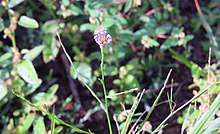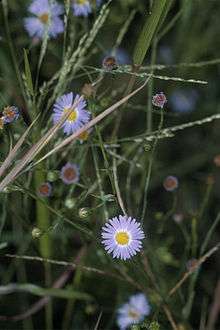Symphyotrichum subulatum
Symphyotrichum subulatum (eastern annual saltmarsh aster or, in Britain and Ireland where it is naturalized, just annual saltmarsh aster[2]) is an annual plant in the sunflower family Asteraceae, native to the eastern US and the Gulf coast to Texas.[3]
| Symphyotrichum subulatum | |
|---|---|
 | |
| Symphyotrichum subulatum in Pemiscot County, MO | |
| Scientific classification | |
| Kingdom: | Plantae |
| Clade: | Tracheophytes |
| Clade: | Angiosperms |
| Clade: | Eudicots |
| Clade: | Asterids |
| Order: | Asterales |
| Family: | Asteraceae |
| Genus: | Symphyotrichum |
| Species: | S. subulatum |
| Binomial name | |
| Symphyotrichum subulatum (Michx.) G.L.Nesom | |
| Synonyms | |
| |
The species grows primarily in coastal salt marshes, although in the Ozarks it occurs as a non-marine weedy variety.[4]
Description
Symphyotrichum subulatum is an annual forb that possesses a single erect stem that can reach up to 1 m in height. The stem, along with its thin green to dark green leaves, are both hairless. The sheathing base-blades of the leaves are ovulate and they consist of margins that are entire. [5]
The top of the stem extends into a raceme inflorescence. The heads open up into bright yellow disc florets that are surrounded by ray florets that vary in color from white to lavender. [6]

Distribution
This is a terrestrial species that will typically grow among grasses of any kind.[5] They are most typically found in areas such as salt marshes, pond margins, sloughs, swamps, crop field margins, lawns, and roadsides. It is thought that they are especially prevalent in these areas because they are tolerant to saline soils and mowing. [7]
S. subulatum is native to the East and Gulf Coasts of the United States, but it is also common across Mexico, the West Indies, Bermuda, Central America, and South America. [6]
Uses
Like other asters, S. subulatum is popular in landscaping and gardening due to its small conspicuous flower head which complements other larger flowers in a flower bed or arrangement. Many plant S. subulatum to attract butterflies and other pollinators to their flower beds or near their beehives. S. subulatum is also used in short-grass meadow restoration in or near its native area. [8]
Varieties
There are currently five different varieties that are identified of this species. The varieties are differentiated based on their chromosome number, ray lamina color and size, array shapes, number of series of ray florets, number of disc and ray florets, and multiple other characteristics. [6] The following are the identified varieties:
- Symphyotrichum subulatum vars. ligulatum
- Symphyotrichum subulatum vars. elongatum
- Symphyotrichum subulatum vars. parviflorum
- Symphyotrichum subulatum vars. subulatum
- Symphyotrichum subulatum vars. squamatum
Each of these varieties exist in very distinct geographic areas from one another, but there are intermediates between the varieties found in locations between two of the varieties. An example of one such intermediate is a population with intermediate ray lamina size between vars. ligulatum and parviflorum that can be found in Southern Texas, New Mexico, Arizona, and northern Mexico. Another example is the intermediates between vars. elongatum and parviflorum and between vars. elongatum and subulatum occur in Florida. [6]
References
- Maiz-Tome, L. (2016). "Aster subulatum". The IUCN Red List of Threatened Species. IUCN. 208. e.T19035773A78457022. doi:10.2305/IUCN.UK.2016-1.RLTS.T19035773A78457022.en.
- "BSBI List 2007". Botanical Society of Britain and Ireland. Archived from the original (xls) on 2015-01-25. Retrieved 2014-10-17.
- "Symphyotrichum subulatum". Natural Resources Conservation Service PLANTS Database. USDA. Retrieved 7 December 2015.
- Gleason, Henry; Cronquist, Arthur (1991). Manual of Vascular Plants of Northeastern United States and Adjacent Canada. Bronx, NY: New York Botanical Garden. p. 590. ISBN 0-89327-365-1.
- Sharma, M. et al. “Symphyotrichum subulatum (Asteraceae)- A first Report of an Alien Weed in India”, Nelumbo. Accessed 2 Nov. 2019.
- Brouillet, L. et al. [http://www.efloras.org/florataxon.aspx?flora_id=1&taxon_id=250049273 “Symphyotrichum subulatum”. Flora of North America. Published 1995. Accessed 2019.
- “Symphyotrichum subulatum” (Michx.) G.L. Nesom- Inland Saltmarsh Aster” Accessed 2019.
- "Symphyotrichum subulatum"University of Texas Plant Database. Accessed Nov. 2019
